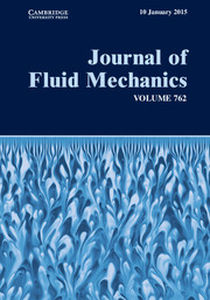Longitudinal and transverse structure functions,  $D_{ll}=\langle {\it\delta}u_{l}{\it\delta}u_{l}\rangle$ and
$D_{ll}=\langle {\it\delta}u_{l}{\it\delta}u_{l}\rangle$ and  $D_{tt}=\langle {\it\delta}u_{t}{\it\delta}u_{t}\rangle$, can be calculated from aircraft data. Here,
$D_{tt}=\langle {\it\delta}u_{t}{\it\delta}u_{t}\rangle$, can be calculated from aircraft data. Here,  ${\it\delta}$ denotes the increment between two points separated by a distance
${\it\delta}$ denotes the increment between two points separated by a distance  $r$,
$r$,  $u_{l}$ and
$u_{l}$ and  $u_{t}$ the velocity components parallel and perpendicular to the aircraft track respectively and
$u_{t}$ the velocity components parallel and perpendicular to the aircraft track respectively and  $\langle \,\rangle$ an average. Assuming statistical axisymmetry and making a Helmholtz decomposition of the horizontal velocity,
$\langle \,\rangle$ an average. Assuming statistical axisymmetry and making a Helmholtz decomposition of the horizontal velocity,  $\boldsymbol{u}=\boldsymbol{u}_{r}+\boldsymbol{u}_{d}$, where
$\boldsymbol{u}=\boldsymbol{u}_{r}+\boldsymbol{u}_{d}$, where  $\boldsymbol{u}_{r}$ is the rotational and
$\boldsymbol{u}_{r}$ is the rotational and  $\boldsymbol{u}_{d}$ the divergent component of the velocity, we derive expressions relating the structure functions
$\boldsymbol{u}_{d}$ the divergent component of the velocity, we derive expressions relating the structure functions  $D_{rr}=\langle {\it\delta}\boldsymbol{u}_{r}\boldsymbol{\cdot }{\it\delta}\boldsymbol{u}_{r}\rangle$ and
$D_{rr}=\langle {\it\delta}\boldsymbol{u}_{r}\boldsymbol{\cdot }{\it\delta}\boldsymbol{u}_{r}\rangle$ and  $D_{dd}=\langle {\it\delta}\boldsymbol{u}_{d}\boldsymbol{\cdot }{\it\delta}\boldsymbol{u}_{d}\rangle$ to
$D_{dd}=\langle {\it\delta}\boldsymbol{u}_{d}\boldsymbol{\cdot }{\it\delta}\boldsymbol{u}_{d}\rangle$ to  $D_{ll}$ and
$D_{ll}$ and  $D_{tt}$. Corresponding expressions are also derived in spectral space. The decomposition is applied to structure functions calculated from aircraft data. In the lower stratosphere,
$D_{tt}$. Corresponding expressions are also derived in spectral space. The decomposition is applied to structure functions calculated from aircraft data. In the lower stratosphere,  $D_{rr}$ and
$D_{rr}$ and  $D_{dd}$ both show a nice
$D_{dd}$ both show a nice  $r^{2/3}$-dependence for
$r^{2/3}$-dependence for  $r\in [2,20]\ \text{km}$. In this range, the ratio between rotational and divergent energy is a little larger than unity, excluding gravity waves as the principal agent behind the observations. In the upper troposphere,
$r\in [2,20]\ \text{km}$. In this range, the ratio between rotational and divergent energy is a little larger than unity, excluding gravity waves as the principal agent behind the observations. In the upper troposphere,  $D_{rr}$ and
$D_{rr}$ and  $D_{dd}$ show no clean
$D_{dd}$ show no clean  $r^{2/3}$-dependence, although the overall slope of
$r^{2/3}$-dependence, although the overall slope of  $D_{dd}$ is close to
$D_{dd}$ is close to  $2/3$ for
$2/3$ for  $r\in [2,400]\ \text{km}$. The ratio between rotational and divergent energy is approximately three for
$r\in [2,400]\ \text{km}$. The ratio between rotational and divergent energy is approximately three for  $r<100\ \text{km}$, excluding gravity waves also in this case. We argue that the possible errors in the decomposition at scales of the order of 10 km are marginal.
$r<100\ \text{km}$, excluding gravity waves also in this case. We argue that the possible errors in the decomposition at scales of the order of 10 km are marginal.



































